


| 5. VIEWING REQUIREMENTS FOR STEREO PHOTOGRAPHS |
| 5.1 Framing and Mounting Requirements |
Previously we saw that preceding correct
procedure during exposure can extremely simplify the task of actually framing
and mounting the picture, whether it be a slide or a print. In the worst
case our result appears as in figure 5.1, i.e. both single views were exposed
with a single camera and differently tilted. In the same figure it is shown
how one can correct the problem without any adjusting device if the pictures
are not to dark. One lays the two film pieces over one another and views
them against a bright light.
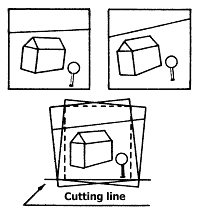
|
|
|
One then brings prominent points or lines together so that they cover one another, edges of buildings or horizontal lines, for example. By holding them fixed in this position with a paper clip or clothes pin , one can now make a cut at the bottom with a sharp knife and ruler as horizontal as possible so that both slides have the bottom edge in common. This may now pass through the perforation; but this does not matter. This common edge must now lie parallel to the bottom edge of the frame's opening, which is not much of a problem
Now one can provide the correct height
using thin parallel wood strips or pieces of cardboard. Crafty hands can
cut a parallel strip with one long diagonal incision into two prism-shaped
sections. These can be pushed along the line of the cut parallel to any
desired height. One can also construct a parallelogram. But then the legs
must be absolutely equal, otherwise the parallel quality vanishes. From
the above instructions follows the supreme law of framing stereographs:
A vertical error (h in fig. 5.3) is forbidden. Also see the second
stereo rule.

|
 |
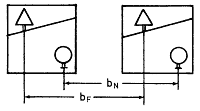 |
|
|
|
|
The prohibition against the vertical error holds for all parts of the picture, which includes the restriction of mutual tilting.
Naturally one can follow all instructions and still come up with a result as in fig. 5.2. It can probably be viewed and projected without any headaches. But you must agree: it is not nice!
The positioning of the single views was already discussed in chapter 3.2 and figure 3.1. Here it is once again repeated: By shifting the single views in the horizontal direction, the spatial image can be moved into the front or into the back of the stereo window. A large separation between the single views moves the spatial image back, whereas a smaller separation moves it forward.
Opinions on the "correct" separation of the two single views in the horizontal directions are divided. Academic thought holds that the spatial image must always stand behind the stereo window: the near-point separation bN in figure 5.4 must then always be about 0.1 mm larger than the frame separation b in figure 20. One may deviate from this (bN<b) only if a pronounced novelty effect is desired, for example, an elephant's trunk or a giraffe's neck extending through the stereo window into the crowd.
This method has the advantage that no "ghost images" of the vertical frame edges appear. This method is currently required in all stereo contests.
The opposite of this is framing with respect
to far-point separation: The measurement b in figure 5.4 should then equal
the frame separation b in figure 5.5.
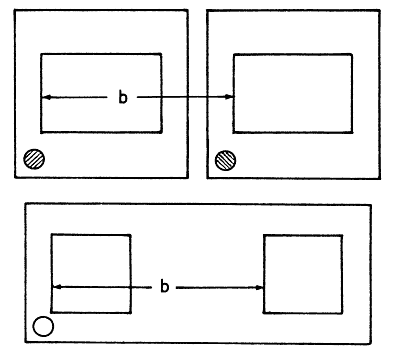
|
|
|
The third version requires the most important
element in the picture to stand in the stereo window. These methods constitute
different points of view which can not be harmonized.
| From DIN 19040 part 8: | Near-point : closest point realized in the stereo picture |
| Far-point : farthest point realized in the stereo picture |
Even a mere part of a twig in the foreground counts as the near-point!
At the bottom of figure 5.5 a "true" stereo mask conforming to DIN 4531 is shown. The frame separation is always 62 mm.
In the following figures 5.6-5.9, a section
from DIN 4531 along with other possible stereo formats is displayed.
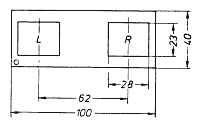 Figure 5.6 Stereo picture of nominal size 41 x 101 mm, shown of effective size of single views 23 x 28 mm |
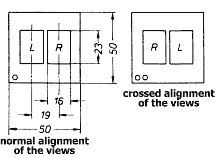 Figure 5.7 Stereo picture of nominal size 50 x 50 mm, effective size of single views 23 x 16 mm (high) |
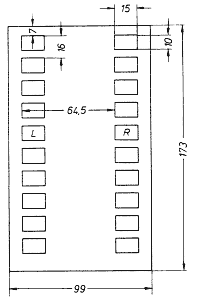 Figure 5.8 Small picture stereo card with 10 sections (Lestrade etc. ...) |
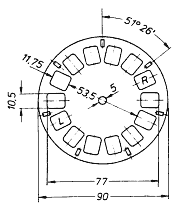 Figure 5.9 Small picture stereo disk with 7 sections (View-Master, Meopta etc. ..) |
Three different sizes of Realist masks, currently manufactured by SIGMA (USA) are available. The windows have a width of 21.5 mm for the normal mask. the medium mask has a width of 20.5 mm, and the close-up mask has a width of 19.5 mm.
With close-ups, the contents of the pictures is shifted toward the outer edges of the picture window (fig. 3.2). Since the pictures are inverted, the contents moves inward when viewing with a stereoscope. The outer edges with the usually distracting contents can then be covered by windows which are up to 2 mm narrower. Of course, distracting elements can also be covered when different formats are being used, e.g., mounting the 23 x 28 mm format in Realist masks in order to achieve a better composition of the picture.
The correct marking of the stereo pictures is important: they should all receive a round marking in the lower left-hand corner when they are upright and the viewing side is facing the front. During projection this mark is then always in the upper right and facing the lamp housing.
Stereo slides in single frames are marked in a similar manner. The only difference being that the right picture is marked with green and the left picture with red as it is with starboard and port in the navigation.
Such labels can be obtained in office supply stores: self-adhesive from AVERY No. 3010 red and 3179 green with a diameter of 8 mm. Colored marking pens may also be used.
Labeling of the slides should likewise be under the or with stereo frames between the pictures so that one can read it while viewing. During projection the labeling will be upside down.
Stereo slides in which both single views lie on one uncut piece of film must be especially marked. As we have already seen in the requirements for exposure. there are two different possibilities: exposures with two small lenses in an interchangeable enclosure or exposures with one lens and a beamsplitter attachment. With the first the single views lie in a correct fashion on the film in the camera while with the last they lie reversed. The slides are marked according to the number of lenses with one or two circles (fig. 5.7).
During exposure the individual single views
are upside down in the camera. In order to view them one must therefore
invert them. If they, as in a true stereo camera, were made on one piece
of film, then the right single view is on the left and the left single
view is on the right. For mounting in a real stereo mask the slides must
be cut from the film strip (fig. 5.10). If this is not respected, a space
inverted pseudoscopic spatial image results (fig. 5.11). The background
appears in front and the foreground in the back.
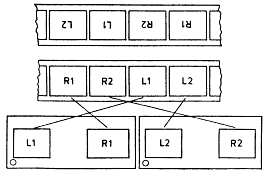
|
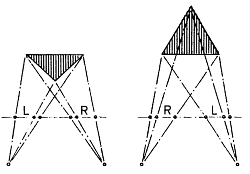 |
|
This is how the single views are arranged in the masks |
Reversal of the spatial image resulting from an exchange of the single views |
Stereo pictures taken with two lenses on one piece of film that may not be cut require a special viewer that optically corrects this transposition of the image (fig. 5.12).
When mounting the slides in glass, especially the true 41 x 101 mm stereo slides, one should always orient from the top edge of the slide. It is at the bottom during projection and determines the quality of the projection. Some of the glass plates have much tolerances. This must be taken into consideration.
The edges of the glass covers and the mount
should constitute a plane. One sets the slide upside down on a straight
surface and insures that all edges lie evenly at the bottom and that the
side edges are correctly aligned. The whole package is then held together
by clothes pin or something similar and the open edges are covered with
adhesive tape. Finally the top edge of the slide is taped. This taped side
must be absolutely flat so that all previous work is not in vain.
| 5.2 Image Differentiation |
For the creation of the spatial image in the brain it is necessary for both of the single views to be individually presented to the eyes.
Different methods are available to achieve this:
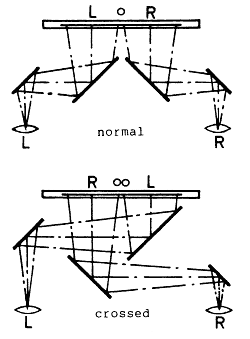
|
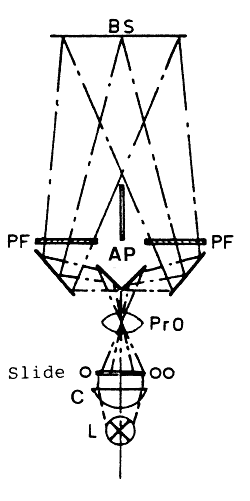 |
|
|
|
|
|
|
The stereo slides exposed with a stereo attachment onto a 24 x 36 mm format require special viewers. The middle separation of the two single views is only 19 mm, while the eye separation from the standard is accepted as 63.5 mm. As with the first Wheatstonian stereoscope, mirrors are employed to accommodate the difference in separation. Only here one must go from a smaller single view separation to the larger separation of the eyes. As was noted in 4.5 in the discussion concerning the different types of stereo attachments, one has to consider with what type of attachment was exposed; if the pictures are correctly positioned or if they are interchanged. (Also see the standard framing procedure (figure 5.7) With the interchanged single view positioning as is produced by exposure with twin lenses, the correct positioning must be recreated for the eyes with an appropriate arrangement of mirrors (fig. 5.12).
It should immediately be mentioned here that during projection an attachment for projection of both types may be used. The position of the polarizing filters must, however, be correctly chosen. The mirrors in the projection attachment must be adjustable. The aperture between the two light beams, with which edge distortion can be screened out, is also important (fig. 5.13).
For the viewing of larger picture format
so-called mirror-stereoscopes are available (fig. 5.14). The viewing path
is diverted by two mirrors. With formats over 25 x 25 cm one can even do
without viewing optics. These large formats are used in the aerial measurement
of land (topographic mapping).
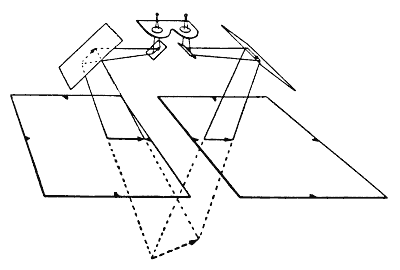
|
|
Scheme of the ray path in a mirror stereoscope |
Another way of viewing of larger 3-D formats,
also in color, is to put them one above the other (fig. 5.15).Prism spectacles
without enlarging divert the eyes axes. The correct viewing distance depends
on the format of the picture, correctly said from the vertical separation
of the centers of the pictures or the angle between the diverted eyes axes
of 13°. So you must adjust yourself till you see only one spatial image.
It is used mainly for 3-D illustrations in books or magazines. The most
known brand is the German KMQ-system. The TVLI Company, Long Island is
the US-partner with the trade mark LEAVISION. The system is called "over
/ under" and enables to view 3-D on a TV-screen without polarizing filters.
There are also spectacles which can be adjusted in a range of 0-16°.
So one can view from different distances.
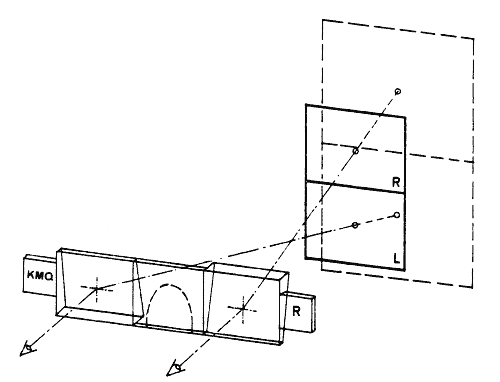
|
|
KMQ Prism Glasses |
To save space, such pictures are also printed one on top of the other. For that purpose one usually utilizes complementary colors, most often red and blue-green. Complementary colors lie exactly opposite of each other in Oswald's circle of color and appear black when viewed subtractively. If one holds two filters of these colors back to back against the light, they together must appear black.
One denotes this method as an anaglyphic procedure. It was already described in 1853 by Rollmann. The word "anaglyph" stems from the Greek and means "prominent relief". This procedure can be used correctly only on black and white pictures.
Conforming to DIN 6170 sheet 1, the right single view is printed or drawn in red and the left view in blue-green. During viewing through anaglyph spectacles with red filters on the left and blue-green filters on the right, the left single view appears dark upon a red field and the right one appears dark upon a green field. Both blend together into a dark spatial image upon a light field. The order of the anaglyph spectacles can be easily remembered: it is the same as the location of the signal lamps on ships: Right/starboard/green and left/port/red.
This standard is not always followed. Therefore one must view the frontispiece of a recent book: La télévision en Relief (3-D television) of the Frenchman Marc Chauvierre with one's glasses "reversed" in order to obtain the correct spatial image.
For the projection of black and white stereo slides one does not have to color them accordingly but instead must place the respective color filters onto the appropiate projection lens.
The English LEE FILTERS Company Ltd., Andover, Hants., SP10 5AN, manufactures such filters. The labeling on the filters is "Primary red" No. 106 and "Primary green" No. 139.
For color slides a different process is
required: one that employs neutral gray filters. Natural light oscillates
in all directions (azimuths). If one sends the light through a filter,
which one can imagine as a narrow grating made from very thin, parallel
strings, only that part of light oscillating in the direction of the strings
will pass through. The light is polarized. Therefore these filters are
called polarizing filters (fig. 5.16).
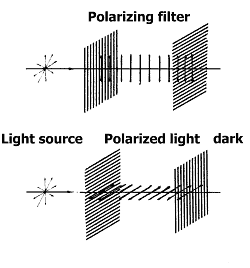
|
|
|
If one introduces a second polarizing filter into the light path, only a part of the polarized light is allowed to pass depending upon the positioning of the second filter. This part becomes null, i.e., it becomes dark, when the angle of the polarizing filters to one another becomes 90°. The amount of attainable darkness is a measurement of the quality of the polarizing filters. Even when the polarizing filters are parallel to one another, only a part of the light passes through since these also act as gray filters.
The desired image differentiation is achieved by associating each eye and its corresponding path of beam with two polarizing filters. These pairs must be parallel to one another and crossed towards each other. One filter is placed on a projector lens and the other in front of one eye as a spectacle. Because of this, each eye sees the light, i.e., the picture from the corresponding projector lens.
Polarized light is also found in nature where it is usually oscillating either vertically or horizontally. In order to avoid distortions from such light, according to DIN 19040 part 8, the oscillating direction for polarizing filters used in stereo viewing must be located under 45°. The two oscillating directions should form a "V" whose legs are perpendicular: Eighth Stereo Rule.
This requirement is already fulfilled in commercial polarizing glasses. The POLAROID Company, USA , which manufactures such glasses of different qualities and price ranges, also offers polarizing filters for projectors of different models. One must compromise between the quality of the polarization and the amount of light the filter allow to pass.
For the projection surface only a material must be used that does not depolarize, i.e., that does not change the polarization of the light (ninth Stereo Rule). Therefore the so-called "silver screens" are used. They are usually sprayed with an aluminum paint. However, the application of a protective coating often inhibits the desired effect. Not every sliver screen is therefore suitable for stereo projection. (Also see the do-it-yourself directions.)
Temporal image differentiation by the successive transmission procedure was first used in the projection of 3-D movies. Primarily, because of technical problems, it did not become popular.
The right and left single views are successively, one after the other, projected onto the screen. The corresponding eye must be uncovered and the other one covered. During projection this is no problem. With a still picture for example, the respective picture is either uncovered or covered by a moving aperture. In a movie, the single views are alternately positioned on the same strip of film (single-strip procedure).
The difficulty lies with the opening and closing the eye covering. This covering must not only be temporally synchronized, but it must also be synchronized with regard to position.
In addition, all of this causes quite a bit of strain upon the eyes. One uses so-called "clapper glasses" with Venetian blinds. An advantage of this procedure is that no light-losing anaglyph or polarizing filters are used and that no silver screen is required. An invention by the English physicist Dr. Robinson is the latest in special glasses, which can be lightened or darkened by electrical fields. The electronic switching in the glasses can be controlled by infrared rays emitted by specially equipped color televisors, which also alternately display the right or left single views. Since the transmitter must also be especially constructed and since this new system is not compatible with the current one, we will probably have to wait quite a while for 3-D color television.
With the raster procedure, also be called lenticular, several pictures are used in the creation of the spatial image. One therefore talks about partial views, which are nested in each other as rasters, rather than of left and right single views. There are both mechanical and optical rasters. All of the methods have in common that the finished pictures cannot be constructed by amateurs. they can be viewed by the naked eye and are generally well known from the spatial looking postcards that are available in many stores nowadays.
A camera with four lenses, with which one
can take such exposures, has been introduced by the NIMSLO Company, USA.
The film must, however, be sent to this company, which holds the patent,
for special processing of the "paper" pictures.
| 5.3 3-D Projection |
A good 3-D slide presentation is the high point of every experience. A prerequisite is an equally good mounting job, since even the best projectionist cannot correct large mistakes made during mounting. With an automatic presentation every thing must be perfect.
Every stereo projector must in addition to the focusing dial have usable controls for horizontal and vertical alignment. These controls must not only be adjusted, but operated. These possibilities must be though of even with two coupled separate projectors.
The stereo rules 1 - 3 do not hold exclusively for slides or exclusively for prints.
During 3-D projection, and the usual enlargement of up to more than 100 times, infringements of rules 2 and 3 are especially noticeable. They are therefore once again repeated here: In the finished framed and mounted picture there is to be no vertical parallax. Identical points in the single views must lie on the same horizontal, and the entire picture should appear as lying behind of the stereo window.
It follows from this that the vertical setting control is the most important on the projector. Not only the errors incurred in framing the slides become evident during viewing, but also the almost unavoidable errors or tolerances in the slide guide in the projector itself. The slide holder may not have too much play or may it be too tight. Especially the latter is most likely to produce vertical distortions if the slides are not correctly situated at the bottom.
But the mechanism that positions the slide in front of the light source also must not have too much play. This is particular the case when the slides, as with single projectors, are moved with grasping levers. A sliding mechanism is inherently better. It is imperative that the picture change occur during a period of darkness, however short. The eyes react with headaches if they have to view stereo pictures on top of, or in each other.
As we saw with the subject of image differentiation,
the two single views are projected on top of each other onto the screen.
In doing so the lenses or the entire projectors are aligned in such a way
that the inner edges of the slides lie exactly on each other. With true
stereo slides 41x101 mm a single calibration is sufficient since the separation
in the mounts should always be the same. With two 5 x 5 slides the above-mentioned
tolerances come into play. Here the vertical position must in certain cases
be readjusted during presentation. The top and bottom edges of the mount
must also lie on top of the other. It is best to use one or two empty frames
for the first adjustment.
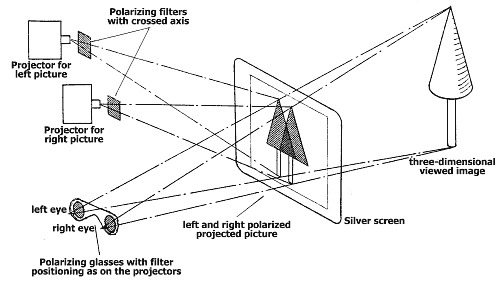
|
|
Stereo slide show with two projectors and polarizing filters |
The accessories required for image differentiation such as anaglyph or polarizing filters can be mounted anywhere between the light source and the screen. Because of the heat one should, however, select a position between the the slide and the lens.. Polarizing filter may be only directly fastened on the lenses if these are not rotated during focusing. Otherwise their relationship with the polarizing glasses it lost. During projection it is unimportant which projector shows the right or left single view. It is sufficient that the correct ordering of the image differentiation accessories is retained. The projectors can be located side by side or one on top of the other. The latter results in less image distortion. Sometimes it is necessary that heat insulation be placed under the top projector so that it is not unnecessary heated by the one below. Because of warranty reasons one fastens the required setting controls onto the base on which the projector rests rather than onto the projector itself.
As was noted earlier, the polarizing filters in the commercial glasses are already set in correct V-position. As single sheets they can be purchased in square or round formats. With the square format the direction of the oscillation is already under 45°, i.e., diagonal to the outside edges. Because of this they are easy to adjust and may require only a rotation of 90°. For calibration, one covers one half of the glasses. The open eye must then see only the light from the corresponding projector. As a control one covers one lens at a time.
With round filters the method is identical.
One rotates the opposite filter until the picture darkens. For example,
the projector showing the right single view is controlled by the left eye.
An adjustment to darkness is more sensitive that one to brightness. The
final setting should be marked on the filter and on the holder so that
no re-adjustment need take place when the filter is removed for cleaning.
It is convenient to cover the filtering sheets with glass plates such as
those from old photo plates.
| 5.4 Rear Projection |
Rear screen projection is also possible with stereo slides, and even produces significantly brighter pictures than are possible with a silver screen. Naturally this requires more room, such as an opening in a wall, if the projector sits on the back side of the projection surface. People in houses that have large sliding doors such as those found in some old residential buildings are in good shape. But an opening between the kitchen and the living room will suffice.
One can use doll glass plates (etched plates depolarize!) But with larger plates the weight is too great and the chance of breaking the glass too high. Special plastic plates that have the same effect are available (MARATA). They are also available in frames up to a few square meters and cost no more than a good silver screen.
The projector or projectors must not be at eye level when using rear projection or else a fleck of light results. One places the projector a little lower and projects at an angle upwards. In doing so one can use a short focal length and one must not forget to place the slide into the projector reversed, so that the audience views it correctly.
These procedures can also be applied to
achieve true spatial backgrounds in room photographs, with that, however,
a polarizing filter must be placed on the corresponding camera lens and
it must be exactly set, as with the polarizing glasses.
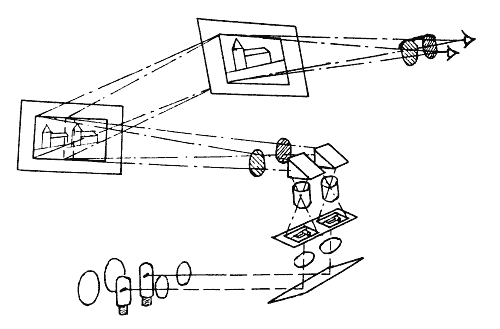
|
|
Table Top Stereo Viewer (rear projection) |
| Previous
Chapter: Exposure Criteria for Stereo Photographs |
Contents |
Next
Chapter: 3-D Movies: Exposure and Projection |
 |
|

| Back to the Services Page |
